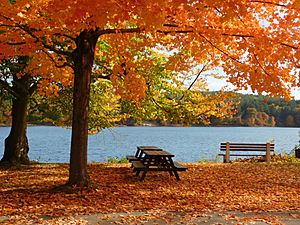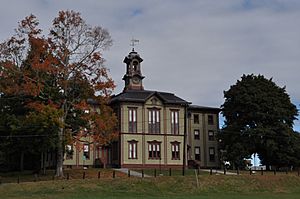Woodstock, Connecticut facts for kids
Quick facts for kids
Woodstock, Connecticut
|
||
|---|---|---|

View from Roseland Park in Woodstock
|
||
|
||
 Windham County and Connecticut Windham County and Connecticut |
||
| Country | ||
| U.S. state | ||
| County | Windham | |
| Region | Northeastern CT | |
| Founded | 1686 | |
| Annexed by Connecticut | 1749 | |
| Government | ||
| • Type | Selectman-town meeting | |
| Area | ||
| • Total | 61.8 sq mi (160.1 km2) | |
| • Land | 60.5 sq mi (156.8 km2) | |
| • Water | 1.3 sq mi (3.4 km2) | |
| Elevation | 794 ft (242 m) | |
| Population
(2020)
|
||
| • Total | 8,221 | |
| • Density | 136/sq mi (52.4/km2) | |
| Time zone | UTC-5 (Eastern) | |
| • Summer (DST) | UTC-4 (Eastern) | |
| ZIP code |
06281, 06282
|
|
| Area code(s) | 860/959 | |
| FIPS code | 09-88190 | |
| GNIS feature ID | 0213541 | |
Woodstock is a town in Windham County, Connecticut, in the United States. It's part of the Northeastern Connecticut Planning Region. In 2020, about 8,221 people lived there.
Contents
Woodstock's History
Early Beginnings in the 1600s
In the mid-1600s, a missionary named John Eliot worked with Native Americans. He created "praying towns" where Native Americans learned about Christianity. They were also asked to change their traditional ways. One of these towns was called Wabaquasset, located near where Woodstock is today. It was the largest praying town in northeastern Connecticut.
In 1675, a big conflict called King Philip's War started. Some Native Americans from Wabaquasset sided with the English and the Mohegans. Others joined the Native American leader, Philip. During this war, Wabaquasset became empty. In 1676, English soldiers and their Native American allies marched through Woodstock. They burned crops and stored food.
In 1682, the Massachusetts colony bought the land that includes Woodstock from the Mohegans. In 1686, 13 men from Roxbury, Massachusetts, settled the area. They named it New Roxbury. In 1690, Judge Samuel Sewall suggested changing the name to Woodstock. He thought it fit because it was near Oxford, Massachusetts. Finally, in 1749, Woodstock became part of Connecticut.
From Farms to Factories: The 1800s
Woodstock was mostly a farming town in the 1700s. After the War of 1812, it started to attract businesses. By 1820, the town had many small industries. These included distilleries, mills for grinding grain, and factories making shoes. Woodstock Valley became known for its shoe factories.
However, by the mid-1800s, most of these industries closed down. Woodstock went back to being a quiet, rural area. It then became a popular summer spot for wealthy people from big cities on the East Coast.
Henry C. Bowen played a big role in this change. Bowen was born in Woodstock. He became rich in the dry-goods business and publishing in Brooklyn, New York. He also started an anti-slavery newspaper called The Independent. Bowen helped create the Republican Party. He built a beautiful home in Woodstock and invested a lot in improving his hometown. Many important people, like Henry Ward Beecher, would visit him in the summers.
Famous Fourth of July Parties
Henry C. Bowen was known for hosting huge July 4 celebrations. These parties took place at his Roseland Park in Woodstock during the late 1800s. Up to 10,000 people would come to these events. They enjoyed speeches, fireworks, and pink lemonade. Bowen, often called "Mr. Fourth of July," later gave Roseland Park to the community. The park included a man-made lake.
Several U.S. Presidents visited Bowen's summer home. These included Ulysses S. Grant, Benjamin Harrison, and Rutherford B. Hayes. They came as his guests and spoke at the July 4th celebrations. President Grant visited while he was still in office. He even spent a night there, even though Bowen did not allow drinking or smoking in his home. Grant had to smoke his cigars on the porch! President Hayes visited in 1883 and spoke about national education. President Harrison came in his first year as president and planted a "liberty tree" during the celebration. Other famous visitors included Henry Ward Beecher and John C. Fremont.
Woodstock's Geography
Woodstock covers about 61.8 square miles (160.1 km²). Most of this is land, with a small amount of water. It is the second-largest town in Connecticut by land area, after New Milford.
Main Communities in Woodstock
Woodstock is made up of several smaller communities:
- East Woodstock
- Harrisville
- Kenyonville
- North Woodstock
- South Woodstock
- West Woodstock
- Woodstock Hill (the town center)
- Woodstock Valley
People of Woodstock
| Historical population | |||
|---|---|---|---|
| Census | Pop. | %± | |
| 1820 | 3,017 | — | |
| 1840 | 3,053 | — | |
| 1850 | 3,381 | 10.7% | |
| 1860 | 3,285 | −2.8% | |
| 1870 | 2,955 | −10.0% | |
| 1880 | 2,639 | −10.7% | |
| 1890 | 2,309 | −12.5% | |
| 1900 | 2,095 | −9.3% | |
| 1910 | 1,849 | −11.7% | |
| 1920 | 1,767 | −4.4% | |
| 1930 | 1,712 | −3.1% | |
| 1940 | 1,912 | 11.7% | |
| 1950 | 2,271 | 18.8% | |
| 1960 | 3,177 | 39.9% | |
| 1970 | 4,311 | 35.7% | |
| 1980 | 5,117 | 18.7% | |
| 1990 | 6,008 | 17.4% | |
| 2000 | 7,221 | 20.2% | |
| 2010 | 7,964 | 10.3% | |
| 2020 | 8,221 | 3.2% | |
| U.S. Decennial Census | |||
In 2000, there were 7,964 people living in Woodstock. There were 3,151 households and 2,330 families. The population density was about 131.6 people per square mile. Most residents were White (97.2%).
About 31.7% of households had children under 18. Most households (62.5%) were married couples. The average household had 2.53 people. The average family had 2.93 people.
The population was spread out by age. About 23.1% were under 18. About 13.4% were 65 or older. The average age was 44.1 years.
The median income for a household was $81,705. For a family, it was $102,008. About 4.7% of the population lived below the poverty line.
Education in Woodstock
Woodstock has its own school district. Woodstock Elementary School serves students from pre-kindergarten to 4th grade. Woodstock Middle School teaches grades 5 through 8. Dr. Francis Baran is the Superintendent.
The town also has a unique school called Woodstock Academy. It's an "Independent New England Academy." This means it's a special public/private school. It's managed by a Board of Trustees.
From 1941 to 1980, Woodstock was home to Annhurst College. This was a private Catholic school.
Woodstock Academy: A Special School
Woodstock Academy was founded in 1801. It's one of only three "corporate schools" in Connecticut. It briefly closed twice in the 1800s. Henry C. Bowen, a local helper and former student, helped reopen it. After he passed away, his family created a fund to help keep the school running.
In 1915, Woodstock Academy became the official public high school for the town of Woodstock. In 1932, the nearby town of Eastford also started sending its high school students there. Woodstock continued to send its students to the Academy until 2004. Even though there have been some disagreements between the town's Board of Education and the Academy's Trustees, Woodstock students still attend the Academy for high school.
Today, the school serves students from Woodstock, Eastford, Pomfret, Union, Canterbury, and Brooklyn. It has over 1,100 students. The school is called "independent" because it's not controlled by any of the towns it serves. It's overseen by the state of Connecticut.
Places to Visit
- Roseland Cottage
- Woodstock Academy
- Camp Meet (on Tyott Road)
See also
 In Spanish: Woodstock (Connecticut) para niños
In Spanish: Woodstock (Connecticut) para niños



